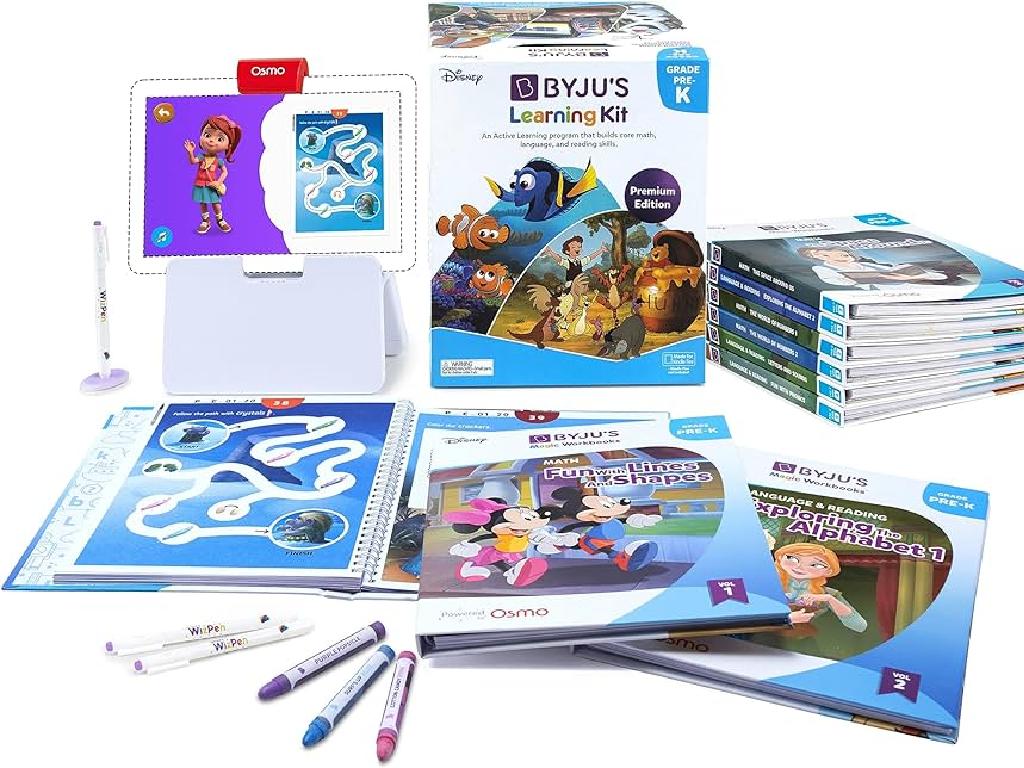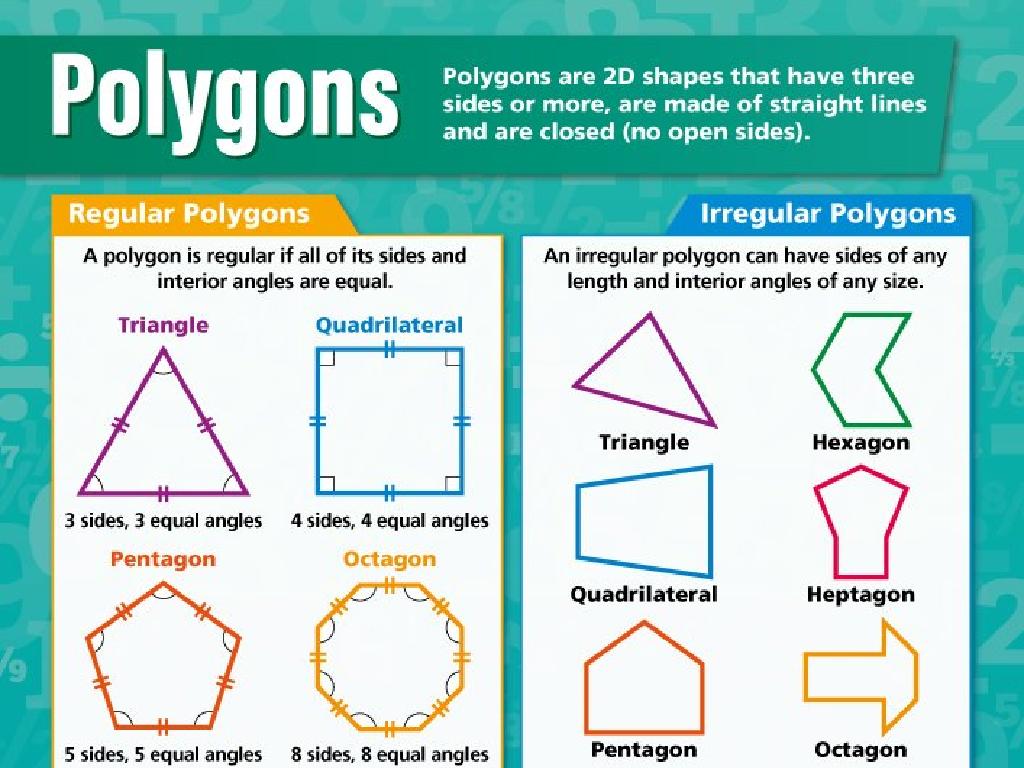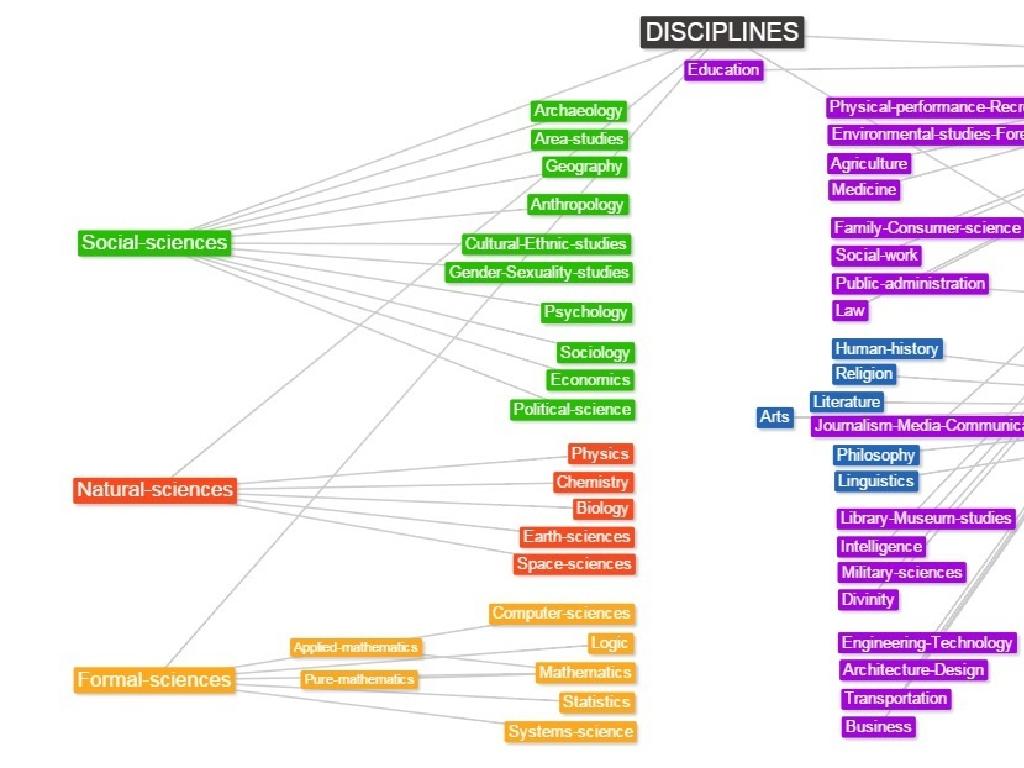Evaluate Numerical Expressions With Parentheses In Different Places
Subject: Math
Grade: Fifth grade
Topic: Numerical Expressions
Please LOG IN to download the presentation. Access is available to registered users only.
View More Content
Evaluating Expressions with Parentheses
– Explore Order of Operations
– Remember: PEMDAS (Parentheses, Exponents, Multiplication/Division, Addition/Subtraction)
– Significance of parentheses
– Parentheses tell us what to solve first in a math problem
– Practice with examples
– Example: (2 + 3) x 4 vs 2 + (3 x 4)
– Parentheses change outcomes
– Compare 5 x 4 = 20 and 2 + 12 = 14 to see the difference
|
This slide introduces the concept of evaluating numerical expressions with parentheses, emphasizing the importance of understanding the order of operations, often remembered by the acronym PEMDAS. Explain why parentheses are crucial in mathematics as they dictate which part of the expression should be calculated first, potentially altering the result of the expression. Provide examples to illustrate how the placement of parentheses can change the outcome of a numerical expression. Encourage students to practice with different expressions to see firsthand the impact of parentheses on their evaluations. The goal is to ensure students can correctly interpret and solve expressions with parentheses.
Understanding Numerical Expressions with Parentheses
– Define numerical expression
– A mathematical phrase combining numbers and operations
– Simple expressions examples
– For instance, 3 + 4 or 6 x 2
– Introduce parentheses
– Parentheses ( ) group parts of expressions to show what to solve first
– Practice with parentheses
|
This slide introduces the concept of numerical expressions to fifth graders, starting with a definition that emphasizes the combination of numbers and operations such as addition, subtraction, multiplication, and division. Provide simple examples without parentheses to ensure students understand the basic structure of expressions. Then, introduce the concept of parentheses, explaining their role in grouping parts of an expression to indicate the order of operations. Emphasize that operations within parentheses should be performed first. Include practice problems to help students apply the concept of parentheses in numerical expressions, reinforcing their understanding through hands-on experience.
The Power of Parentheses in Numerical Expressions
– Parentheses affect expression results
– Parentheses tell us which numbers to work with first
– Compare expressions with/without parentheses
– Example: 2 + (3 x 4) vs 2 + 3 x 4
– Grouping with parentheses
– We group numbers/operations to control the order
– Practice using parentheses
|
This slide introduces the concept of how parentheses can change the outcome of numerical expressions. It’s crucial for students to understand that parentheses are used to indicate which operations should be performed first in an expression. Provide examples to show the difference in results when parentheses are used versus when they are not. For instance, 2 + (3 x 4) equals 14 because we do the multiplication inside the parentheses first, but 2 + 3 x 4 equals 20 if we follow the standard order of operations without parentheses. Encourage students to practice grouping different numbers and operations with parentheses to see how it affects the result. This will help solidify their understanding of the order of operations and the importance of grouping in mathematics.
Mastering Order of Operations: PEMDAS
– Review PEMDAS rules
– PEMDAS: Parentheses, Exponents, Multiplication/Division, Addition/Subtraction
– Determine first operation
– Identify the first operation in 3 × (4 + 2) vs 3 × 4 + 2
– Parentheses change order
– Parentheses tell us to do that part first: (2 + 3) × 5 vs 2 + (3 × 5)
– Practice with examples
– Solve sample problems: 6 + (2 × 4) and (6 + 2) × 4
|
Begin with a quick review of the PEMDAS acronym, which stands for Parentheses, Exponents, Multiplication and Division (from left to right), Addition and Subtraction (from left to right). This will help students remember the correct order of operations. Next, present examples to illustrate which operations to perform first. Emphasize how parentheses can change the usual order by requiring the operation within them to be completed first. Provide practice problems for students to apply these concepts, ensuring they understand the impact of parentheses on the order of operations. Encourage students to solve the problems step-by-step and to check their work.
Let’s Practice Together: Parentheses in Expressions
– Walkthrough: evaluating expressions
– Example: Evaluate 3 x (4 + 2) step by step
– Class interaction: suggest steps
– Students will volunteer to suggest the next step in solving the expression
– Real-time misconception correction
– Address and explain any mistakes as they occur
– Reinforce correct evaluation methods
|
This interactive slide is designed for a class activity where the teacher will guide students through the process of evaluating a numerical expression with parentheses. Start with a simple example and evaluate it step by step, encouraging students to participate by suggesting what to do next. This will not only engage them but also allow for immediate feedback and correction of any misconceptions. Emphasize the importance of the order of operations and how parentheses can change the outcome of a numerical expression. Prepare to reinforce the correct methods and ensure students understand why each step is taken.
Your Turn: Evaluating Expressions with Parentheses
– Practice evaluating expressions
– Use tips to check your work
– Double-check by recalculating; look for errors in operations
– Help classmates with challenges
– Discuss your methods and reasoning with a partner
– Share your solutions and strategies
– Explain your thought process to the class
|
This slide is designed for individual practice where students will apply their knowledge to evaluate expressions with parentheses. Encourage them to carefully follow the order of operations. Provide tips such as checking their work by recalculating and looking for common mistakes like incorrect addition or multiplication. Promote a collaborative classroom environment by urging students to help each other and discuss their strategies. After the activity, have a few students share their solutions and the strategies they used to reach their answers. This will help reinforce their understanding and build confidence in their problem-solving abilities.
Class Activity: Expression Creation!
– Create expressions with parentheses
– Swap with a partner to solve
– Discuss challenges faced
– Did you face any difficulty with order of operations?
– Share solutions with the class
– How did you overcome any tricky parts?
|
This activity is designed to engage students with hands-on practice in creating and evaluating numerical expressions with parentheses. Students will first create their own expressions, ensuring they understand how parentheses affect the order of operations. They will then exchange their expressions with a partner, which encourages peer learning and collaboration. After solving, a group discussion will allow students to talk about any difficulties they encountered and how they resolved them, promoting critical thinking and problem-solving skills. As a teacher, facilitate the discussion by guiding them through the process of evaluating expressions and encourage them to explain their reasoning. Possible activities could include creating expressions that result in a specific number, using a set number of operations, or incorporating real-life scenarios into their expressions.
Wrapping Up: Expressions with Parentheses
– Recap: Evaluating expressions
– Homework: Practice worksheet
Complete the worksheet with various expressions.
– Reminder: Consistent practice
The more you practice, the better you’ll understand.
– Keep practicing at home!
|
As we conclude today’s lesson, remind students of the key concepts we’ve covered about evaluating numerical expressions with parentheses. Emphasize the importance of the order of operations and how parentheses can change the outcome of an expression. For homework, assign a worksheet that includes a variety of expressions for students to evaluate, ensuring they apply what they’ve learned in class. Encourage them to practice regularly as this will help solidify their understanding of the topic. During the next class, be prepared to review the homework answers and address any questions or difficulties the students may have encountered.





